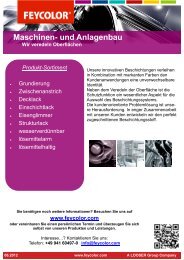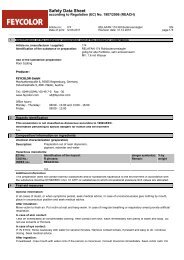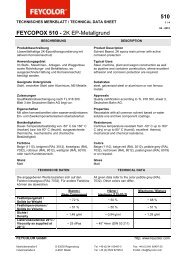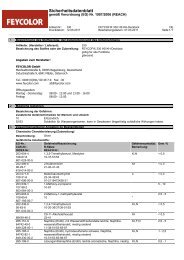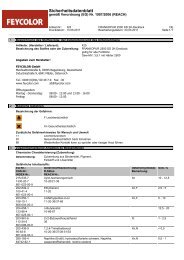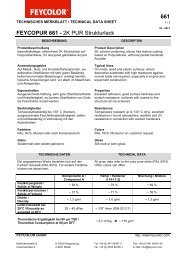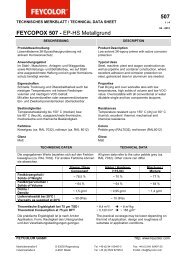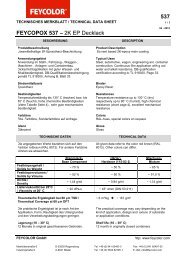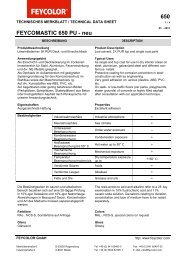Safety Data Sheet - Feycolor Gmbh
Safety Data Sheet - Feycolor Gmbh
Safety Data Sheet - Feycolor Gmbh
You also want an ePaper? Increase the reach of your titles
YUMPU automatically turns print PDFs into web optimized ePapers that Google loves.
<strong>Safety</strong> <strong>Data</strong> <strong>Sheet</strong><br />
according to Regulation (EC) No. 1907/2006 (REACH)<br />
Article no.: 623<br />
Date of print: 13.05.2011<br />
Protective measures:<br />
After contact clean skin thoroughly with water and soap oder use appropriate cleanser.<br />
9. Physical and chemical properties<br />
Appearance:<br />
Physical state: liquid, see viscosity!<br />
Paint: see productname<br />
Odour: typical<br />
RELONIT 2K-PU Eisenglimmer EN<br />
Revision date: 30.03.2011 page:4 / 6<br />
<strong>Safety</strong> relevant basis data Measured values unit Method Remark:<br />
Flash point: 23 °C<br />
Ignition temperature (AIT): 315 °C<br />
lower explosion limit: 0,9 Vol-%<br />
Upper explosion limit: 15,0 Vol-%<br />
Vapour pressure at 20 °C: n.a.<br />
density at 20 °C: 1,65 g/cm³<br />
Water solubility (g/l): insoluble<br />
pH at 20 °C: n.a.<br />
Viscosity at 20 °C: > 60 s 6 mm DIN 53211<br />
Solvent separation test (%): < 3 %<br />
Solid content (%): 78 % by weight<br />
solvent content:<br />
Organic solvents:: 22 % by weight<br />
Water: 0 % by weight<br />
10. Stability and reactivity<br />
Conditions to avoid<br />
Stable when applying the recommended regulations for storage and handling. Further information on correct storage: refer to<br />
chapter 7. Hazardous decomposition byproducts may form with exposure to high temperatures.<br />
Materials to avoid<br />
Keep away from strong acids, strong bases and strong oxidizing agents to avoid exothermic reactions.<br />
Hazardous decomposition products<br />
Hazardous decomposition byproducts may form with exposure to high temperatures, e.g.: carbon dioxide, carbon monoxide,<br />
smoke, nitrogen oxides.<br />
11. Toxicological information<br />
No data on preparation itself available.<br />
Practical experience<br />
Other observations:<br />
Inhaling of solvent components above the MWC-value can lead to health damage, e.g. irritation of the mucous membrane and<br />
respiratory organs, as well as damage to the liver, kidneys and the central nerve system. Indications for this are: headache,<br />
dizziness, fatigue, amyosthenia, dizziness, in serious cases: unconsciousness. Solvents may cause some of the<br />
aforementioned effects through skin resorption. Repeated or prolonged contact with the preparation may cause removal of<br />
natural fat from the skin resulting in non-allergic contact dermatitis and/or absorption through skin. Splashing may cause eye<br />
irritation and reversible damage.<br />
Overall Assessment on CMR properties:<br />
The components in this formulation do not meet the criteria for classification as CMR category 1 or 2.<br />
There is no information available on the preparation itself . The preparation has been assessed following the conventional<br />
method of the Dangerous Preparations Directive 1999/45/EC and classified according to the toxicological dangers.See<br />
chapters 2 and 15 for details.<br />
12. Ecological information<br />
Overall evaluation:<br />
There is no information available on the preparation itself .<br />
Do not allow to enter into surface water or drains.<br />
Results of PBT assessment<br />
The components in this formulation do not meet the criteria for classification as PBT or vPvB.



